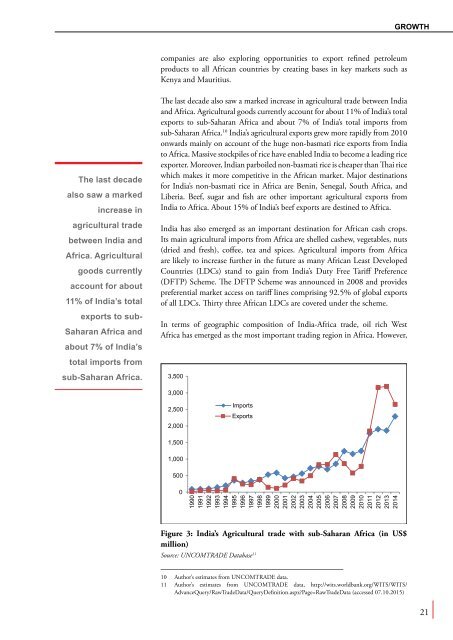Common Futures
II3UUw
II3UUw
Create successful ePaper yourself
Turn your PDF publications into a flip-book with our unique Google optimized e-Paper software.
growth<br />
companies are also exploring opportunities to export refined petroleum<br />
products to all African countries by creating bases in key markets such as<br />
Kenya and Mauritius.<br />
The last decade<br />
also saw a marked<br />
increase in<br />
agricultural trade<br />
between India and<br />
Africa. Agricultural<br />
goods currently<br />
account for about<br />
11% of India’s total<br />
exports to sub-<br />
Saharan Africa and<br />
about 7% of India’s<br />
The last decade also saw a marked increase in agricultural trade between India<br />
and Africa. Agricultural goods currently account for about 11% of India’s total<br />
exports to sub-Saharan Africa and about 7% of India’s total imports from<br />
sub-Saharan Africa. 10 India’s agricultural exports grew more rapidly from 2010<br />
onwards mainly on account of the huge non-basmati rice exports from India<br />
to Africa. Massive stockpiles of rice have enabled India to become a leading rice<br />
exporter. Moreover, Indian parboiled non-basmati rice is cheaper than Thai rice<br />
which makes it more competitive in the African market. Major destinations<br />
for India’s non-basmati rice in Africa are Benin, Senegal, South Africa, and<br />
Liberia. Beef, sugar and fish are other important agricultural exports from<br />
India to Africa. About 15% of India’s beef exports are destined to Africa.<br />
India has also emerged as an important destination for African cash crops.<br />
Its main agricultural imports from Africa are shelled cashew, vegetables, nuts<br />
(dried and fresh), coffee, tea and spices. Agricultural imports from Africa<br />
are likely to increase further in the future as many African Least Developed<br />
Countries (LDCs) stand to gain from India’s Duty Free Tariff Preference<br />
(DFTP) Scheme. The DFTP Scheme was announced in 2008 and provides<br />
preferential market access on tariff lines comprising 92.5% of global exports<br />
of all LDCs. Thirty three African LDCs are covered under the scheme.<br />
In terms of geographic composition of India-Africa trade, oil rich West<br />
Africa has emerged as the most important trading region in Africa. However,<br />
total imports from<br />
sub-Saharan Africa.<br />
3,500<br />
3,000<br />
2,500<br />
2,000<br />
Imports<br />
Exports<br />
1,500<br />
1,000<br />
500<br />
0<br />
1990<br />
1991<br />
1992<br />
1993<br />
1994<br />
1995<br />
1996<br />
1997<br />
1998<br />
1999<br />
2000<br />
2001<br />
2002<br />
2003<br />
2004<br />
2005<br />
2006<br />
2007<br />
2008<br />
2009<br />
2010<br />
2011<br />
2012<br />
2013<br />
2014<br />
Figure 3: India’s Agricultural trade with sub-Saharan Africa (in US$<br />
million)<br />
Source: UNCOMTRADE Database 11<br />
10 Author’s estimates from UNCOMTRADE data.<br />
11 Author’s estimates from UNCOMTRADE data, http://wits.worldbank.org/WITS/WITS/<br />
AdvanceQuery/RawTradeData/QueryDefinition.aspx?Page=RawTradeData (accessed 07.10.2015)<br />
21








